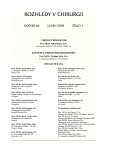Injuries to the Biliary Tract during Cholecystectomy
Authors:
V. Třeška *; T. Skalický *; J. Šafránek *; B. Kreuzberg **
Authors‘ workplace:
Chirurgická klinika FN v Plzni, přednosta prof. MUDr. V. Třeška, DrSc.
*; Radiodiagnostická klinika FN v Plzni, přednosta doc. MUDr. B. Kreuzberg, CSc.
**
Published in:
Rozhl. Chir., 2005, roč. 84, č. 1, s. 13-18.
Category:
Monothematic special - Original
Overview
Injuries to the biliary tract during both the laparoscopic or the open cholecystectomic procedures, remain among the most serious iatrogenic injuries with high morbidity and mortality rates. The higher the number of the laparoscopic cholecystectomies, the higher the number of the injuries to the biliary tract. Early peroperative recognition of these injuries is a prerequisite for successful biliary tract reconstructions. Mucosal hepaticojejunoanastomosis according to Roux is the golden standard of the reconstrucion treatment. Stenoses in anastomoses followed by development of cholangitides are considered serious postoperative complications. In these cases, endoscopic and transparietal dilation with plastic stents implantation is the method of choice. Technically exacting reoperations then follow. The authors present a trial group of 11 patients, who were treated in the Surgical Clinic of the Faculty Hospital in Plzeň for biliary tract injuries during cholecyctomic procedures (8 were laparoscopic and 3 open), from 01-01-2000 to 01-09-2004. Severe inflammatory changes in the region of the Calot triangle, were the commonest cause of the biliary tract injuries during primary operations. In most cases (N = 8) the injury was diagnosed and managed immediately during the primary procedure. Hepaticojejunoanastomosis according to Roux was the principal procedure used to repair the biliary tract (N = 8). Postoperative morbidity reached 36.4%, 2 elderly patients exited (18.2%) due to septic multiorgan failure on the 15th day and the 7th month after the surgical procedure. Multidisciplinary approach of a team of experienced surgeons, endoscopists and radiologists in the hepatobiliary region is a fundamental prerequisite for long-term successful outcomes of technically exacting reconstructive procedures of the hepatobiliry tract.
Key words:
cholecystectomy – biliary tract injuries – diagnostics – treatment
Labels
Surgery Orthopaedics Trauma surgeryArticle was published in
Perspectives in Surgery

2005 Issue 1
Most read in this issue
- Injuries to the Biliary Tract during Cholecystectomy
- Hemipelvectomy for a Desmoidal Tumor
- Anatomical Resection for Liver Metastases of the Carcinoma of the Large Intestine and the Rectum
- The Cystadenocarcinoma of the Appendix
